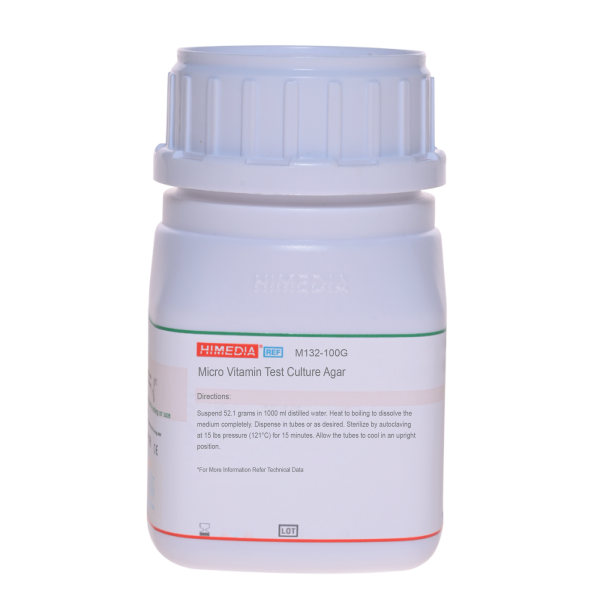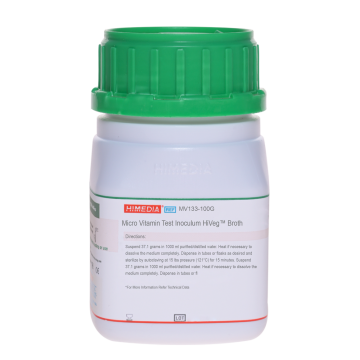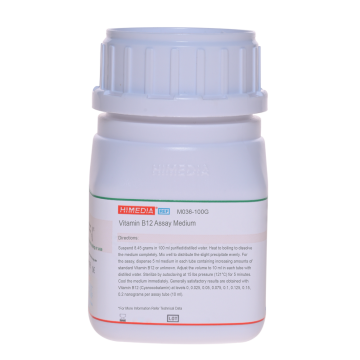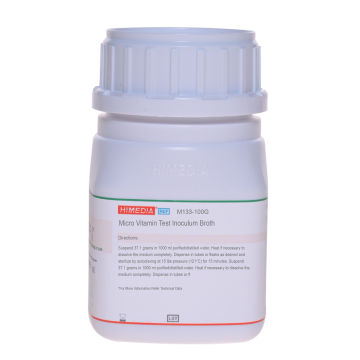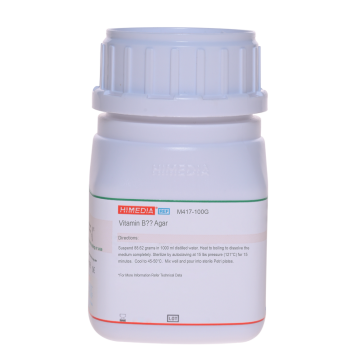 Your enquiry has been submitted
Your enquiry has been submitted
Micro Vitamin Test Culture Agar
Intended Use:
Recommended for cultivation and maintenance of stock cultures of Lactobacilli used in microbiological assays of vitamins.
Composition**
| Ingredients | Gms / Litre |
|---|---|
| Yeast extract | 20.000 |
| Peptone | 5.000 |
| Dextrose (Glucose) | 10.000 |
| Potassium dihydrogen phosphate | 2.000 |
| Polysorbate 80 (Tween 80) | 0.100 |
| Agar | 15.000 |
| Final pH (at 25°C) | 6.7±0.2 |
**Formula adjusted, standardized to suit performance parameters
Directions
Suspend 52.1 grams in 1000 ml purified / distilled water. Heat to boiling to dissolve the medium completely. Dispense and sterilize by autoclaving at 15 lbs pressure (121°C) for 15 minutes. Cool to 45-50°C. Mix well and pour into sterile Petri plates.
Principle And Interpretation
Lactobacillus is a genus of gram-positive facultative anaerobic lactic acid bacteria. The lactic acid bacid bacteria are so named because most of its members convert lactose and other sugars to lactic acid. They are common and usually benign. Many species are prominent in decaying plant material. The production of lactic acid makes its environment acidic which inhibits the growth of some harmful bacteria. Three types of media are generally used in microbiological assays namely maintenance media, inoculum /cultivation media and the test assay media.
Micro Vitamin Test Agar is used for carrying stock cultures of Lactobacilli and other test organisms used in microbiological assays (1). This media can also be used for routine cultivation of Lactobacilli in microbiological assays of vitamins and in inoculum preparation for assays.
Peptone and yeast extract in the medium provide nitrogen, sulphur, vitamins and other essential nutrients for growth. Dextrose is the energy source. Polysorbate 80 is the fatty acid source. Potassium dihydrogen phosphate buffers the medium.
Stock cultures are prepared by stab inoculation in triplicates. One is used for preparation of stock cultures while others are used for inoculum preparation for assays. Transfer of cultures should be made at weekly or biweekly intervals.
Suspend a 16-24 hours culture of Lactobacilli from Micro Vitamin Test Culture Agar into Micro Vitamin Test Inoculum Broth. After an incubation at 35-37°C for 18-24 hours, centrifuge the culture and decant the supernatant. Re-suspend the centrifuged cells in 10 ml of sterile saline suspension. Repeat the washing two more times. Dilute the washed cell suspension with basal assay medium or as desired to obtain the required density of cells.
For procedure of Vitamin Assay, refer standard references (2).
Type of specimen
Isolated Microorganism
Specimen Collection and Handling:
Stock cultures are prepared by stab inoculation in triplicates. One is used for preparation of stock cultures while others are used for inoculum preparation for assays.
After use, contaminated materials must be sterilized by autoclaving before discarding.
Warning and Precautions :
Read the label before opening the container. Wear protective gloves/protective clothing/eye protection/ face protection. Follow good microbiological lab practices while handling specimens and culture. Standard precautions as per established guidelines should be followed while handling specimens. Safety guidelines may be referred in individual safety data sheets.
Limitations :
- Transfer of cultures should be made at weekly or biweekly intervals.
Performance and Evaluation
Performance of the medium is expected when used as per the direction on the label within the expiry period when stored at recommended temperature.
Quality Control
Appearance Cream to yellow homogeneous free flowing powder
Gelling Firm, comparable with 1.5% Agar gel
Colour and Clarity of prepared medium Light yellow coloured clear to slightly opalescent gel forms in tubes as butts
Reaction Reaction of 5.2% w/v aqueous solution at 25°C. pH : 6.7±0.2
pH 6.50-6.90
Cultural Response
Cultural characteristics observed after an incubation at 35 - 37°C for 24 - 48 hours.
| Organism | Inoculum (CFU) | Growth |
|---|---|---|
| Lactobacillus casei ATCC 9595 | 50-100 | good-luxuriant |
| Lactobacillus viridescens ATCC 12706 | 50-100 | good-luxuriant |
| Lactobacillus leichmannii ATCC 4797 | 50-100 | good-luxuriant |
| Lactobacillus plantarum ATCC 8014 | 50-100 | good-luxuriant |
Storage and Shelf Life
Store between 10-30°C in a tightly closed container and the prepared medium at 20-30°C. Use before expiry date on the label. On opening, product should be properly stored dry, after tightly capping the bottle in order to prevent lump formation due to the hygroscopic nature of the product. Improper storage of the product may lead to lump formation. Store in dry ventilated area protected from extremes of temperature and sources of ignition. Seal the container tightly after use. Use before expiry date on the label.
Product performance is best if used within stated expiry period.
Disposal
User must ensure safe disposal by autoclaving and/or incineration of used or unusable preparations of this product. Follow established laboratory procedures in disposing of infectious materials and material that comes into contact with clinical sample must be decontaminated and disposed of in accordance with current laboratory techniques (3,4).
Reference
- Atlas R. M., 1993, Handbook of Microbiological Media, Parks L.C., (Ed.), CRC Press, Inc.
- Horwitz, (Ed.), 2000, Official Methods of Analysis of AOAC International, 17th Ed., Vol. I, AOAC International, Gaithersburg, Md.
- Isenberg, H.D. Clinical Microbiology Procedures Handbook 2nd Edition.
- Jorgensen, J.H., Pfaller, M.A., Carroll, K.C., Funke, G., Landry, M.L., Richter, S.S and Warnock., D.W. (2015) Manual of Clinical Microbiology, 11th Edition. Vol. 1.
| Product Name | Micro Vitamin Test Culture Agar |
|---|---|
| SKU | M132 |
| Product Type | Regular |
| Physical Form | Powder |
| Origin | Animal |
| Packaging type | HDPE |
| References | 1. Atlas R. M., 1993, Handbook of Microbiological Media, Parks L.C., (Ed.), CRC Press, Inc. 2.Horwitz, (Ed.), 2000, Official Methods of Analysis of AOAC International, 17th Ed., Vol. I, AOAC International,Gaithersburg, Md. |
| Customized Product Available | No |



